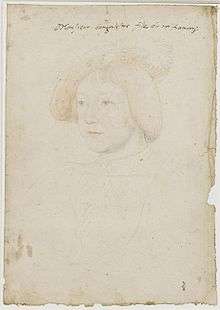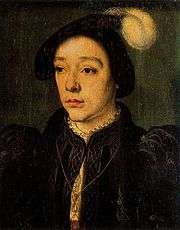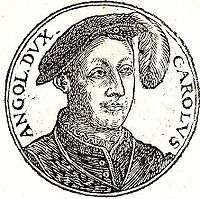Charles II de Valois, Duke of Orléans
| Charles II de Valois | |
|---|---|
| Duke of Orléans | |
 | |
| Born | 22 January 1522 |
| Died | 9 September 1545 (aged 23) |
| House | Valois-Angoulême |
| Father | Francis I of France |
| Mother | Claude of France |
Charles II of Orléans (22 January 1522 – 9 September 1545) was the third son of Francis I and Claude of France.
Duke of Orléans

From his birth until the death of his oldest brother Francis, Dauphin of France (Francis I's eldest son), in 1536, Charles was known as the Duke of Angoulême. After his brother's death, he became Duke of Orléans, a titled previously held by his surviving brother Henry, who had succeeded Francis as Dauphin and would later become King of France as Henry II.
By all accounts, he was the most handsome of Francis I's sons. Smallpox made him blind in one eye, but it seems that it was not noticeable. He was known for his wild antics, his practical jokes and his extravagance and frivolousness, which his father approved of wholeheartedly.[1] He was, by far, his father's favorite son. In addition, he was popular with everyone at his father's court, and it was widely believed that the French nobility of the time would have much preferred to have him as the Dauphin as opposed to his downcast brother, Henry, who never seemed to recover from his years of captivity in Spain.[1]
| French Monarchy |
| Capetian Dynasty, House of Valois (Valois-Angoulême branch) |
|---|
.svg.png) |
| Francis I |
| Henry II |
| Francis II |
| Charles IX |
| Henry III |
In 1540 he was granted the title of Count of Clermont.[2]
In 1542, Francis I and Charles V, Holy Roman Emperor, again went to war against each other. Charles fought and captured Luxembourg, but then fearful that he would miss the glory of Perpignan, which was under siege by the Dauphin Henry, he headed south. Luxembourg was lost and retaken several times during the war.
Marriage arrangements

On 19 September 1544, the Treaty of Crépy was signed. Charles had a choice to marry one of two relatives of the Emperor:
One option was Infanta Maria of Spain, daughter of Emperor Charles V and Isabella of Portugal, with the Netherlands or the Low Countries of Franche-Comté as her dowry.
The other option was Archduchess Anna of Austria, daughter of Ferdinand I, King of Hungary and Bohemia and Anna of Bohemia and Hungary. She was a niece of Charles V through her father and would receive Milan as her dowry. As the groom's father, Francis I was expected by the Treaty to endow his son with Angoulême, Châtellerault, Bourbon and Orléans.
The Peace of Crépy deeply offended Charles' elder brother the Dauphin Henry and his wife, Catherine de' Medici. As a minor point, Henry considered Milan to be his birthright anyway, as the heir of Valentina Visconti. More importantly, his brother Charles would by this settlement become as powerful as a monarch, and would be supported by the Emperor, dividing French interests, and creating a strategic nightmare. Many historians believe that this is exactly what Charles V, hoping to use Charles of France as an adversary against Henry, had in mind.
Death
The rivalry between Charles and his brother, the Dauphin Henry, was potentially dangerous. However, it solved itself with the death of Charles. In the autumn of 1545, Charles was on his way (with his brother, the Dauphin) to Boulogne, which was under siege. On 6 September, they came across a cluster of houses that had been emptied and sealed off "from the plague"—probably a form of influenza. Stating that "no son of a King of France ever died of plague", Charles entered some of the infected houses with his brother.[3] Laughing, he slashed at bedding with his sword and started a pillow fight with some of his traveling companions. Stories have also been told of him (on a dare) lying down on one of the infected beds and rolling around on the bedding. Later that evening, after dining with his father and brother, he took suddenly ill, suffering from pain, a high fever, vomiting and shaking limbs. His brother rushed to his sickroom immediately, but was barred from entering, being physically restrained on three occasions.
Charles died on 9 September 1545. Some thought that he had been poisoned, but most agreed that it was the "plague" that killed him. He is buried next to his father, Francis I and his brother, the Dauphin Francis at the Abbey of Saint-Denis.
At the time of his death, he possessed the Duchies of Angoulême, Bourbon, and Châtellerault.
Anecdotes
- Charles was known for his wild antics. Stories have it that once he jumped up behind Charles V, Emperor of the Holy Roman Empire, and his father's sworn enemy and shouted, "You are my prisoner". Apparently, Charles V spurred his horse into a frantic gallop without once looking behind him. His brother, Henry, was delighted at the fright his brother gave the Emperor.
- His father's Swiss Guard nicknamed him "Abednago".[1]
Ancestry
| Ancestors of Charles II de Valois, Duke of Orléans | ||||||||||||||||||||||||||||||||||||||||||||||||||||||||||||||||||||||||||||||||||||||||||||||||||||||||||||||||||||||||||||||||||||||||||||||||||||||||||||||||||||||||||||||||||||||||||||||||||||||||||||||||||||||||||||||||||||||||||||||||||||||||||||||||||||||||||||||||||||||||||||||||||||||||||||||||||||||||||||||||||||||||||||||||||||||||||||||||||||||||||||||||||||||||||||||||||||||||||||||||||||||||||||||||||||||||||||||||||||||||||||||||||||||||||||||||||||||||||||||||||||||||||||||||||||||||||||||||||
|---|---|---|---|---|---|---|---|---|---|---|---|---|---|---|---|---|---|---|---|---|---|---|---|---|---|---|---|---|---|---|---|---|---|---|---|---|---|---|---|---|---|---|---|---|---|---|---|---|---|---|---|---|---|---|---|---|---|---|---|---|---|---|---|---|---|---|---|---|---|---|---|---|---|---|---|---|---|---|---|---|---|---|---|---|---|---|---|---|---|---|---|---|---|---|---|---|---|---|---|---|---|---|---|---|---|---|---|---|---|---|---|---|---|---|---|---|---|---|---|---|---|---|---|---|---|---|---|---|---|---|---|---|---|---|---|---|---|---|---|---|---|---|---|---|---|---|---|---|---|---|---|---|---|---|---|---|---|---|---|---|---|---|---|---|---|---|---|---|---|---|---|---|---|---|---|---|---|---|---|---|---|---|---|---|---|---|---|---|---|---|---|---|---|---|---|---|---|---|---|---|---|---|---|---|---|---|---|---|---|---|---|---|---|---|---|---|---|---|---|---|---|---|---|---|---|---|---|---|---|---|---|---|---|---|---|---|---|---|---|---|---|---|---|---|---|---|---|---|---|---|---|---|---|---|---|---|---|---|---|---|---|---|---|---|---|---|---|---|---|---|---|---|---|---|---|---|---|---|---|---|---|---|---|---|---|---|---|---|---|---|---|---|---|---|---|---|---|---|---|---|---|---|---|---|---|---|---|---|---|---|---|---|---|---|---|---|---|---|---|---|---|---|---|---|---|---|---|---|---|---|---|---|---|---|---|---|---|---|---|---|---|---|---|---|---|---|---|---|---|---|---|---|---|---|---|---|---|---|---|---|---|---|---|---|---|---|---|---|---|---|---|---|---|---|---|---|---|---|---|---|---|---|---|---|---|---|---|---|---|---|---|---|---|---|---|---|---|---|---|---|---|---|---|---|---|---|---|---|---|---|---|---|---|---|---|---|---|---|---|---|---|---|---|---|---|---|---|---|---|---|---|---|---|---|---|---|---|---|---|---|---|---|---|---|---|---|---|---|---|---|---|---|---|---|---|---|---|---|---|---|---|---|---|---|---|---|---|---|---|---|---|---|---|---|---|---|---|---|---|---|---|---|---|---|---|---|---|---|---|---|---|---|---|---|---|---|---|---|---|---|---|---|---|---|---|---|---|---|---|---|---|---|---|---|
| ||||||||||||||||||||||||||||||||||||||||||||||||||||||||||||||||||||||||||||||||||||||||||||||||||||||||||||||||||||||||||||||||||||||||||||||||||||||||||||||||||||||||||||||||||||||||||||||||||||||||||||||||||||||||||||||||||||||||||||||||||||||||||||||||||||||||||||||||||||||||||||||||||||||||||||||||||||||||||||||||||||||||||||||||||||||||||||||||||||||||||||||||||||||||||||||||||||||||||||||||||||||||||||||||||||||||||||||||||||||||||||||||||||||||||||||||||||||||||||||||||||||||||||||||||||||||||||||||||
Notes
- 1 2 3 Seward, Desmond (1973). Prince of the Renaissance: The Golden Life of François I. New York: Macmillan Publishing Co. p. 228.
- ↑ Prime, Temple (1903). "Note on the County of Clermont". Notes Relative to Certain Matters Connected with French History. 1. De Vinne Press. p. 103. Retrieved 11 August 2016 – via Google Books.
Charles, Duke of Orleans, was Count of Clermont from 1540 to 1545, when he died leaving no issue.
- ↑ Seward, Desmond (1973). Prince of the Renaissance: The Golden Life of François I. New York: Macmillan Publishing Co. p. 241.
